Shipyard Employment eTool
Fire Protection >> Precautions for Hot Work
To reduce the potential of fire hazards and the frequency and severity of any fires resulting from hot work, OSHA has identified specific precautions for hot work. The term "hot work" is defined as riveting, welding, burning or other fire- or spark-producing operations. This section covers all hot work operations except for those requirements found in Confined and Enclosed Spaces and Other Dangerous Atmospheres in Shipyard Employment.
Sparks or molten metal from hot work, when combined with oxygen and a fuel source, can start a fire. Hot work is only allowed in areas that are free of fire hazards, or where fire hazards have been controlled by physical isolation, fire watches, or other positive means. Employers must maintain hazard free conditions in the space while hot work is being performed.
Other hazardous conditions can also result in fires. Potential ignition sources include combustible materials that may cause or contribute to the spread of fire such as cigarettes, matches, heat guns, heat producing chemical reactions, electric shocks, and improper use of heating devices. While these conditions are not covered by the following requirements, OSHA encourages employers to control all fire-hazards found in shipyard employment.
- Precautions for hot work
- Training. See Fire Protection: Training for specific requirements.
Review the Confined/Enclosed Spaces and Other Dangerous Atmospheres before proceeding with this section.
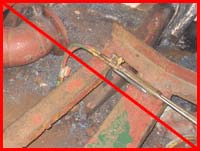
Potential Hazards
- Unprotected combustible materials exposed to hot work.
- Fire and explosion hazards.
- Uncontrolled hot work.
- Failure to recognize flammable materials such as rubber, foam insulation, wiring, deck covering, wallboard.
- Performing hot work in non-designated locations.
- Spark-producing devices not observed by user (Figure 1).
- Burning of materials causing toxic gases or atmospheres.
- Oxygen-deficient and oxygen enriched atmospheres while performing hot work.
- Protective covers that have been moved, become deteriorated, contaminated, or unsuitable for the purpose.
- Fuel line and oxygen hose breakage.
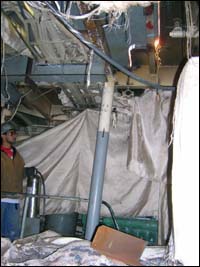
Requirements and Example Solutions
- Designated areas for hot work may be identified in sites such as vessels, vessel sections, fabricating shops, and subassembly areas that are free of fire hazards. [1915.503(a)(1)]
- In a non-designated area, a visual inspection of the area must be conducted prior to performing hot work. This includes adjacent spaces to ensure that the area is free of fire hazards, unless a Marine Chemist's certificate or Shipyard Competent Person's log is used for authorization. [1915.503(a)(2)(i)]
-
Hot work can only be performed in areas free of fire hazards, or where fire hazards have been controlled by physical isolation, fire watches, or other positive means (Figure 2 and 3). [1915.503(a)(2)(ii)]
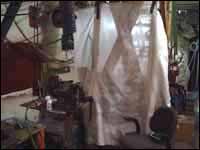
- See 1915.14 for additional hot work requirements.
-
Hot work areas must be free of new hazards likely to cause or contribute to the spread of fire. [1915.503(b)(1)]

- Fire, gas and oxygen supply lines and torches must be adequately maintained. [1915.503(b)(2)]
- No unattended fuel gas and oxygen hose lines or torches are in confined spaces (Figure 1).
- No unattended charged fuel gas and oxygen hose lines or torches are in enclosed spaces for more than 15 minutes.
- All fuel gas and oxygen hose lines are disconnected at the supply manifold (Figure 4) at the end of each shift.
- All disconnected fuel gas and oxygen hose lines are rolled back to the supply manifold (Figure 5) or to open air to disconnect the torch or extended fuel gas and oxygen hose lines are not reconnected at the supply manifold unless the lines are given a positive means of identification when they were first connected and the lines are tested using a drop test or other positive means to ensure the integrity of the fuel gas and oxygen burning system.
-
Gas lines (oxygen, acetylene and other flammable gases) must be disconnected at the source at the end of each shift and the discharge end of each hose removed from confined or enclosed spaces. [1915.503(b)(2)]
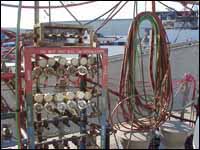
- Only use gas hoses (oxygen, acetylene and other flammable gases) that are in good repair. [1915.55(f)]
- For additional precautions and requirements while performing hot work, please see:
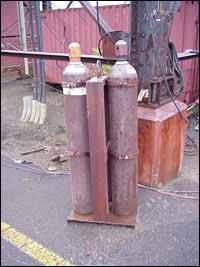

- Ensure that any cold work being conducted in adjacent spaces is compatible with hot work being performed.
- Thoroughly inspect adjacent spaces and protective covers before conducting hot work.
- Clearly identify space boundaries where hot work is to be conducted (Figure 7).
- Maintain good housekeeping practices (removal of rags and trash) (Figure 8) and train on combustible materials such as wiring and insulation adjacent to hot work.
- Remove combustible or flammable coatings or preservers (bulkhead coatings, floor coatings).
-
Remove combustive materials (rubber, shrink wrap, foam insulation, wiring, deck covering, wallboard) or ensure that they are covered with shielding materials.
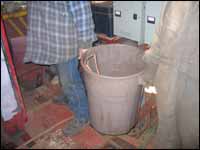
- Direct hot work away from openings or cover the openings.
- Equipment such as torches and cutting and welding apparatus should be stored so as to prevent tampering by unauthorized persons.
- Equip torch operators with hose clamps in case of accidental gas line breakage in the line.
- If an unattended torch is found in enclosed or confined spaces, hot work should be stopped, the area evacuated, gases secure at the source, and test atmosphere prior to starting work.
- Develop a hot work permit program for:
- all hot work on vessels.
- hot work in designated areas shoreside.
- Ensure workers are properly trained on the hot work permit program.

